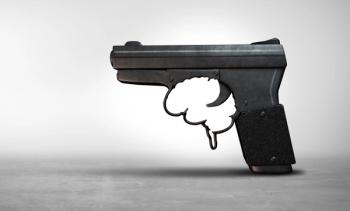
In Praise of Empathy: An Application of Social Psychiatry
Empathy will help patients feel they are understood and can better facilitate physician-patient interactions. Here’s how.
COMMENTARY
With President Biden’s first speech to the nation focused on
In the business world and in popular culture, empathy has gained steady prominence. Daniel Goleman popularized the term emotional intelligence (or EI) in 1995, opining that it is as equal if not more important than IQ.1 Later, in a Harvard Business Review article “What Makes a Leader,” Goleman discusses EI as the sine qua non of leadership and again as a core communication skill.2
The business practice of design thinking encourages organizations to research customer empathy as key to understanding marketplace product or service need and solution design. Empathy is all the more important given our growing multicultural reality.
What is empathy? Can professional consultants, coaches, physicians, attorneys, MBAs, human resource professionals, clergy, therapists, and others think deeper about the merits of empathy? In what follows, I will explore these questions.
Two Types of Empathy
While several definitions exist, 2 generic types of empathy are evident. First, one-way empathy is the capacity to relate, be simpatico, or read others. George Herbert Mead called this “taking the role of the other.” Hence, we thoughtfully consider others and their viewpoint during our interaction. This is often easier said than done in today’s climate of extreme views. We may have to practice a maturity once voiced by F. Scott Fitzgerald, who
Practicing Empathy
The communication of empathy with another provides a supportive context, even a healing aspect for both patient and practitioner whether coach, consultant, physician, or therapist. Two-way empathy supports a patient’s self-validation and can encourage further self-exploration. As change agents, we are a thought-partner who allows a patient to move to deeper levels of self-exploration with our empathetic communication. Moreover, isolation diminishes and interpersonal effectiveness increases. Empathy helps us feel less alone, especially if it is two-way empathic communication.
When we converse with another we can verbally and nonverbally acknowledge what we are hearing. The preeminent psychologist Carl R. Rogers, PhD, advocated for this style of communication.3 He suggested empathy was an attitude, a check in with another individual to confirm understanding of their comments. This promotes communication.
With this type of empathy, we are not offering interpretations of what we hear or see or sense. We are not searching for unconscious processes, nor are we searching for how to disagree. While somewhat superficial, this empathy type is critical to promote self-esteem and a sense of safety in others during our interaction. We bolster our own self-concept while also supporting the self-concept of others when we acknowledge understanding (whether we agree with their comments or not). With two-way empathy, we convey safety and trust in a patient or other client without judgement. We thereby model kindness, general understanding, and tolerance. Moreover, we hope the patient builds or exercises growth in their own empathy.
There is a deeper empathy too that should be acknowledged. The noted psychiatrist Heinz Kohut, MD, calls this vicarious introspection.4 Here, we move beyond mere recognition and
- What is the entirety or the whole of the other’s perceived situation?
- What are conscious and unconscious elements of a patient’s life history?
- What might it be like to be the other?
We may or may not communicate our answers to such questions to the other person, but we strive to understand more deeply what is being communicated. Kohut suggests we value empathy as a facilitative method to enable a patient to receive interpretations. Of course, not all patients can tolerate the depth of our empathetic response. Hence, practitioners must gauge patient acceptance while we simultaneously gauge our ability to communicate sensitive areas in our interactions.
Coaching has value here, without being overly therapeutic. Organization consultants and others might not be sufficiently experienced to embrace this empathy type. Therapists, on the other hand, often make use of vicarious empathy.
Another aspect of empathy can be identified as a here and now or moment to moment style of patient interaction. We strive to be in the patient’s shoes in total, as the psychiatrist R.D. Laing, MD, voiced. Laing even embraced this deep type of empathy for use with his psychotic patients. To merge with another using a here and now approach, we are aware of a patient’s movements, postures, gestures, facial expressions, comments, and pauses in communication.
Several human growth impromptu approaches also embrace verbal and nonverbal sensitivity to a patients’ total presentation. These include J.L. Moreno, MD’s “
Here and now micro practice is most suitable for experienced professionals. We think and feel our way into a patient’s inner world and undertake their journey as partners. As practitioners we grasp our patients’ struggle and help articulate and explore their concerns through empathy. Reflection on a patient’s comments takes place, yet content, feelings, and interpretations may all help promote client development.
Concluding Thoughts
As mentioned, the approaches to empathy explored above may in part overlap. Here and now empathy however is best applied in a therapeutic context, while the other 2 forms may be most useful with coaches and organization consultants. Some approaches may be useful in tandem and not applied exclusively. Nevertheless, the goal is patient recognition that they are understood. Being understood may facilitate their problem solving and/or growth. We must use empathy with positive intention, and never use it with negative intention (as a means to psychopathic, sadistic, or other selfish ends).
Other
Dr Green is a former National Endowment for the Humanities Fellow.
References
1. Goleman D. Emotional Intelligence. Bantam Books; 1995.
2. Goleman D. What makes a leader? Harvard Business Review. January 2004. Accessed October 6, 2021.
3. Rogers CR. On Becoming a Person. Houghton Mifflin Company; 1961.
4. Kohut H. How Does Analysis Cure? University of Chicago Press; 1984.
Newsletter
Receive trusted psychiatric news, expert analysis, and clinical insights — subscribe today to support your practice and your patients.














